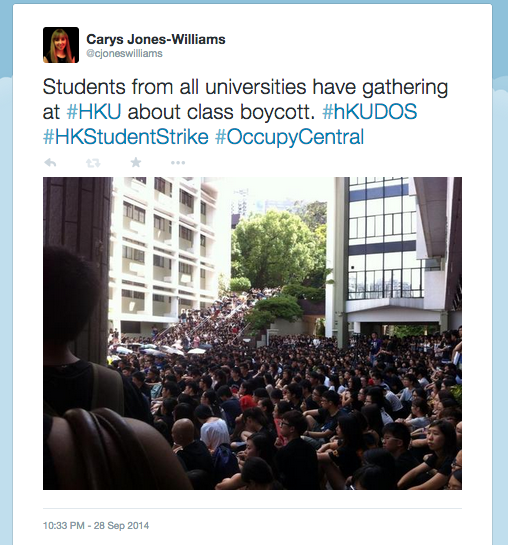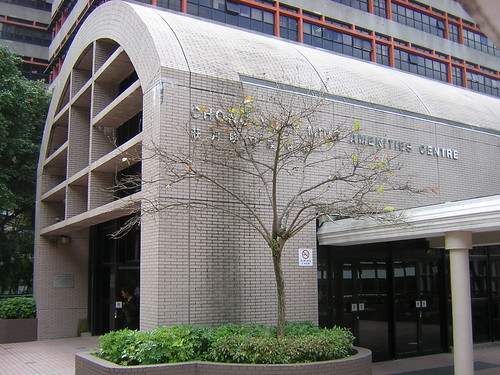I've held back from blogging about this as things are constantly changing and you knew there was something coming in the next few days. The Umbrella Revolution is not yet over but things have certainly slowed down, and I feel like it's finally time to touch upon such an important topic. I'm not going to touch on the politics, nor everything that happened to everyone, but wanted to give an insight into the world I've been surrounded by the past few months.
Start of September 2014: The whispers start
Beijing will not give Hong Kong universal suffrage in the 2017 elections - they will have to choose their Chief Executive from a pre-picked selection of candidates from Beijing. In the uproar from the public, and especially students, Benny Tai, a law lecturer at University of Hong Kong, and the other co-founders of Occupy Central with Love and Peace announce they will hold a mass protest and 'occupy' the roads around the Government offices. No date is announced.
 |
| Injustice anywhere is a threat to justice everywhere, banner on HKU campus |
The streets are filled with whispers. Everyone has their own opinion, and are strong about it. We talk in hushed whispers on the street, and at dinner tables, in the hope someone nearby won't be offended at another's opinions. People wonder when Occupy Central will begin - will it be on October 1st (China's National Day) or will they surprise on another day? Will you attend? Will I attend? What will China do? As a foreigner, should I go? Will I help support the cause, or fuel conspiracies about foreign forces intervening? What will the Government do? How will it end? Nobody knows, but everyone wants to talk. There's fear, excitement, hope and curiosity hanging in the air.
26th September 2014: The students raise their voices
Well, something is happening. The students are no longer in whispers. They are almost at the end of their week-long strike. The Universities have made adjustments for those who strike - nobody will be penalised for missing classes, our lecturers reassure the class. Students turn out in huge numbers and I visit them on the Friday, taking in what they are doing. First, I must walk through the park and the anti-democracy camp - filled mostly with older people, largely wearing matching red caps and yellow shirts. Chinese flags fly high alongside the Hong Kong flag. I'm surprised by the lack of aggression and clashes between the anti-democracy protesters and the hoards of democracy protesters walking through the same park.
 |
| The anti-democracy protesters at Tamar Park |
Further along the path, I notice a man blocking the way - his eyes search for people wearing a yellow democracy ribbon and directs them down a small side path into Civic square. I follow the teenage schoolchildren coming straight from school to join the University students in their boycott. It's small, but busy and incredibly vibrant - at the centre is a large, cordoned off area with a lecture in Cantonese being given to a few hundred students, but it's the activities around the edges of the square that are most interesting. A number of small gazebos have students huddled under them, out of the sun and listening to various talks. There's even a life-size monopoly board game on the floor, although I couldn't read the Chinese characters but I am sure had some political point, and a drama group doing some impromptu theatre to a few dozen protesters they've managed to gather. There are plenty more students sitting around - some offering out free food and water, others painting t-shirts or simply chatting together. There's a real buzz of achievement and of hope - you can sense the strength of the protesters.
I doubt either the protesters, and especially myself, realised the scale of what was to happen that weekend. The following night, in response to a number of student protesters being arrested, Occupy Central would begin.
28th September 2014: The City stands up
I awoke in the morning to the news that in the middle of the night, the announcement everyone had been waiting for had come. Occupy Central had begun. Thousands of people were already on the streets. Both out of nervousness and a rapidly decreasing public transport service into Central - I made the decision to stay home and follow the progress remotely. I followed live CCTV coverage online, twitter and social media, news agencies, and as we sat in our common room, my floor mates translated the news as we all watched nervously. The police used 87 canisters of tear gas against the non-violent protesters, using only umbrellas to protect themselves. Back in the common room, speaker announcements asked us to take supplies down to the shelter our accommodation had opened in the hall, which we did. Eventually, the police retreated and we went to bed not knowing what would happen tomorrow.
29th September 2014: The city shouts
Nothing had happened overnight - the resilient students, and scores of the public, remained put on the busiest road in Hong Kong, occupying the Government Offices just as they promised. That evening, with no further violence or clashes, we decided it would be safe to visit the protests. By now, the crowds had swelled massively in response to the previous day's brutality. I must admit that I have never seen anything so powerful, moving or that gives me so much hope for the future and puts my faith back in humanity than this visit.
When we first arrived, I took the first aid supplies I had brought to one of the many stations - where they insisted on giving me goggles and a mask for my protection. The protesters were well looked after - the air was still hot and sticky, and people spritzed us with water, offered us food and drink (although we declined) and I could see a number of first-aid tents well-stocked and on hand.
We climbed up to the pedestrian bridge, and leaning over the edge was spectacular - there was an endless crowd as far as we could see, and that's when people began lifting their phones into the air and a beautiful sea of lights swept over the crowd. People sang songs, held up signs of hope, and stood by the students who had been harmed the day before. The police didn't make a move against them. Over 100,000 people turned out that evening - people got turned away from Central as it became too full, and smaller Occupy Mong Kok and Occupy Causeway Bay protests began as an overflow. Visiting Mong Kok, the roads were still full of buses - trapped from when a wave of people descended, now eerily abandoned and turned into paper-covered monuments of support for Democracy. The city was overcome with a community spirit, respect and hope that is not easily done.
I'm afraid I only have relatively bad photo quality, but it can give at least give an idea of the scale.
 |
October 2014: The city keeps talking
 |
| Student meeting, deciding to continue the class-boycott |
The next time I visited the Occupy Central site was at the one month mark, and many students were still boycotting class. In the media, the protest camp was described as small - but in reality there were still hundreds taking shifts at keeping the camp alive. As unlikely as it seemed, a small community-driven village had developed in the middle of Hong Kong's busiest main road. The floors were brightly coloured with chalk drawings, streams of banners flew from the bridges, and tents claimed 'addresses' such as 26 democracy street.
 |
| Community Garden |
December 2014: They still have their voices
I'm about to leave Hong Kong to travel home from Christmas. It's been over two months since Occupy Central, and resentment towards the traffic problems it causes is growing - and the government are slowly taking action. I decide for one last visit before I leave. It's smaller again, though hundreds still remain, and the community spirit of Occupy's village is strong. The study centre is busy with students, as finals draw nearer. Tinsel decorates various tents, and some have Christmas trees, decorated with yellow origami umbrellas, outside their doors. One tent has even created a 'lawn' out front with fake grass. The camp is, as usual, spotlessly clean.
 |
| Occupy Central Study Centre |
I find a leather workshop making yellow democracy ribbon charms with your name stamped onto the leather. I take up the offer from a student working there, and we get talking. He tells me only a few days ago the police were attacking protesters further down the road. He says he can handle it, that it won't stop him, but he saw them beating up an old lady. However, if you talk to the elderly involved they protest they are there to support the students - that it is the young people who are the most important and the ones they want to protect. Despite my initial worries before this all began that I would be viewed as an unwelcome foreigner, they welcome me with open arms - the more there are, the stronger they will be, they say. They want me to spread their message to the UK.
My emotions are all over the place - I am so proud of their efforts, their hope, yet I'm sad because I have a niggling feeling they won't be here much longer.
 |
| The 'small' protest camp left by December |
January 2014: Back to Whispers
I'm back from Christmas, and they're gone. The Police cleared them out in December. The occupation lasted 79 days, but Hong Kong, Harcourt Road and it's pollution levels are back to normal. It's no longer what everyone is talking about, but small signs that hope still hasn't gone can be found - especially on campus, with posters, banners and yellow ribbons hanging off people's bags. It's difficult to know where people's minds are at - and what the future holds. Whilst it's not expected to hold another Occupy any time soon, there are whispers of protests and rallies in the coming weeks.
February 2014: To be continued...


































